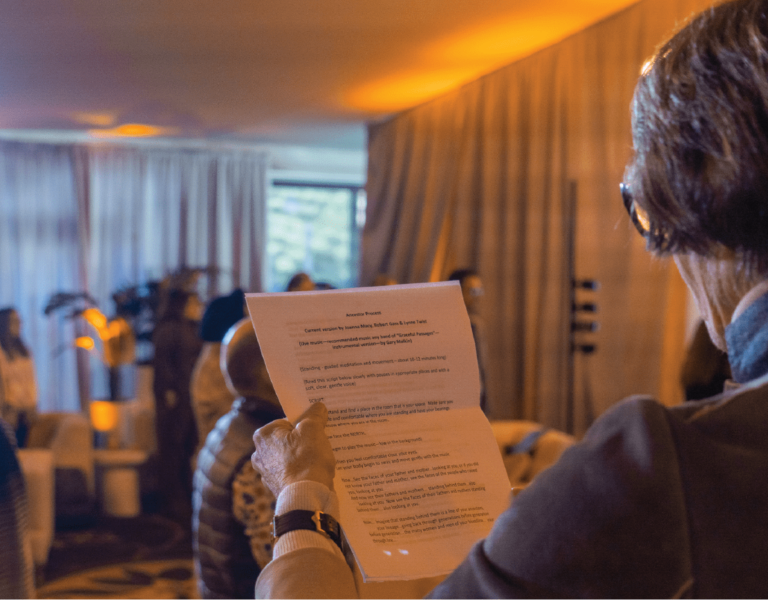Years spent communicating remotely and being glued to our smartphones have left many of us hyper-focused on the present. To reconnect with ourselves and our place in the world, we can start by cultivating our strong and weak ties.
If you’re like me, you could do without another Zoom meeting. Years spent communicating remotely and being glued to our smartphones have left many of us hyper-focused on the present. And many of us are starting to think beyond that. We’re feeling a pull to find our bigger “Why.” I believe this year is all about reconnecting—to other people, to ourselves and to our place in the world.
That all starts with reconnecting to other people. And it needs to be more than a Zoom call. Like it or not, we’re creatures of flesh and blood. When you’re talking to someone online, you’re not talking to another person. You’re talking at a glass screen displaying an animated LED picture of that person. And trust me. Your body knows the difference. It’s time to meet up in person again.
When considering who to reconnect with, make sure you pay attention to people you know really well and people you don’t know well at all. That’s what sociologists call strong ties and weak ties. Strong ties are close connections: your inner circle of trusted friends and confidants. These are people who you work with, live with and socialize with regularly. As my brother once told me, “Good friends remind you of who you are.” But weak ties are equally important. They’re the loose network of people who you might not know that well. Weak ties expand your view of the world.
Studies show that close relationships are a better predictor of overall happiness and longevity than social class, IQ or genetics. For this type of connection, you need to be able to go deep with people who are like you. But it’s not enough to stop there. Ironically, when reconnecting with yourself and the world, it helps to expand your perspective rather than focusing solely on what’s familiar. That’s where weak ties come in.
Studies show how weak ties can be a more important determinant of your professional success than strong ties. They allow you to learn of new opportunities and ideas across siloed social networks and across economic and demographic divides. That seems especially important now.
To grow your weak ties, start by stepping outside your comfort zone. For example, if you’re a pretty straitlaced guy, go spend a week at the Burning Man festival to practice radical openness and self-expression. If you’re a suburban white executive, go attend the Essence Festival to experience one of the largest annual celebrations of African American culture and music. And if you’re an avowed atheist, maybe attend a local church. You may be surprised by what you learn.
Most professional settings are good for developing weak ties. We’ve all been to conferences where we came home with a stack of business cards or new LinkedIn connections. Most of those ties will remain weak. It takes a little work to find a venue that’s designed to engender strong ties with peers.
Oops! We could not locate your form.
For the last seventeen years, I’ve been a member of the Young Presidents’ Organization, a group of over 25,000 CEOs worldwide who are invited to join when they’re under 40. (And yes, that was some time ago for me…) As part of that group, I joined a “forum” of eight people. Our forum meets every month for four hours. That’s four hours, once a month… for seventeen years.
We talk about how our lives are going, how our businesses are doing and how we’re feeling. All manner of topics come up, from “My son is having problems in school” to “I need to fire my CFO.” And what happens in forum stays in forum. It’s an unusually safe space for people in a job that can be surprisingly isolating. The CEO title doesn’t confer moral or intellectual superiority. It’s just a highly particular role, and it’s great to have an intimate circle of people who can relate to the unique challenges of your job. Not that long ago, my partner Colleen joined Chief, a similar network for female execs.
Years ago, a client of mine asked me if there was a similar kind of experience for heads of strategy and innovation. He was looking for a place to connect with people just like him. Try as I might, I couldn’t think of such a place. So we decided start one. And that’s how we created the Jump Offsite.
We didn’t want the Offsite to be just about expanding your professional network. Our clients needed more than business cards. So we made sure the speakers were great, but we also found ways to nurture close connections. At the Offsite, small groups of hand-selected peers go deep with each other. Conversations start off with questions like, “How do you define success in your job?” and “How long do you plan on doing this for?” before going into questions like “What are you really afraid of?”
And that’s why these groups of strong ties also matter, especially now. When you’re responsible for growth or strategy or innovation in a large company, it can often feel like you’re the only one who’s focused on the future. Coming to the Offsite helps leaders to feel the strength of a community and find their people. And through closed-door deep dives and conversations, they get the wisdom of their peers.
To be sure, we’re all very busy. It’s hard to justify making time for reconnection, much less such intentional investments in both strong and weak ties. But, if there’s one thing I learned at the Offsite last year, it’s this: The next ten years will have an outsized impact on the next thousand years of the human condition, because of climate change, and artificial intelligence, and increased social fragmentation. The actions that we all take in our day jobs will impact generations to come, so we need to choose wisely. How we spend our time and what we choose to prioritize matters more now than ever.
Don’t be surprised if just by reconnecting with both folks who are like you and not like you, you end up reconnecting with who you are and what your place is in this world.
This article appeared in Forbes on March 10, 2024.

 Dev Patnaik
Dev Patnaik



